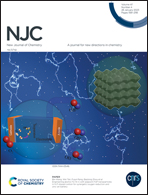Preparation and characterization of a form-stable phase change hydrogel for heat-protective clothing†
Abstract
Phase change materials with appropriate transition temperatures can help to regulate body temperature to a suitable range. In this work, a form-stable phase change hydrogel (PCH) was prepared as a heat-protective clothing lining material. In detail, binary eutectic hydrated salts (BEHSs, CaCl2·6H2O–MgCl2·6H2O), which were used as the phase change materials, were encapsulated into a polyacrylamide (PAAm) 3D crosslinked network by one-step radical polymerization. FT-IR, XRD, and SEM were used to characterize the microstructure of the PCH and the results show that the crystals of hydrated salts were distributed in the PAAm network uniformly. Thus, the hydrogel network prevents the leakage of salt solutions and maintains a stable shape. Phase change energy storage and thermal properties of the PCH were characterized by DSC and the results show that this PCH has a high phase transition enthalpy (140 J g−1) and a suitable phase transition temperature (25 °C). Try-on tests show that the surface temperature of the PCH can remain below 25 °C for nearly 4 hours on a hot day, effectively reducing the damage caused by high temperatures to the human body. This study describes a simple method for making a form-stable PCH, as well as an alternative to microencapsulation or traditional melt impregnation for making composite phase change energy storage materials.



 Please wait while we load your content...
Please wait while we load your content...